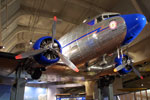Ironically, the story of the DC-3 began with a famous airline crash. In 1931, a Fokker tri-motor operated by Transcontinental & Western Air (TWA) went down, killing all seven people on board, including famed University of Notre Dame football coach Knute Rockne. When an investigation of the crash revealed that the wood wing of the Fokker was weakened by rot, airlines began scrambling to replace wood-framed planes with all-metal ones. TWA asked several manufacturers for proposals for a new, all metal airplane, with two or three engines, weighing no more than 14,200 pounds, able to carry at least 12 passengers at 150 miles per hour, with a range of 1,080 miles. Douglas Aircraft, which had previously concentrated on military planes, proposed a twin-engine aircraft that they called the Douglas Commercial Number 1, or simply DC-1. TWA chose the Douglas design, but before it went into production an improved version was developed, called the DC-2.

Read more about The Henry Ford’s DC-3 airplane |
The DC-2 was an instant success, but C.R. Smith, president of American Airlines, wanted something more. For long overnight flights he wanted a plane that could hold up to 14 sleeping berths. Douglas Aircraft engineers enlarged and improved the DC-2 to create a new plane, called the Douglas Sleeper Transport, or DST. When configured with 21 seats (seven more than the DC-2) rather than sleeping berths, this plane was called the DC-3. Airlines soon discovered that the DC-3 was so economical to fly that it could make money carrying passengers alone, even if there was no mail or other cargo to transport. Pilots found it easier to fly than the DC-2. Author and pilot Ernest Gann described the DC-3 as “an amiable cow that was forgiving of the most clumsy pilot.” Passengers liked the added comfort and safety afforded by the DC-3. It quickly became the standard airliner of the world. A military version, called the C-47, was the workhorse transport of World War II. Between 1936 and 1946 Douglas made over 10,000 DSTs, DC-3s, and C-47s. Many are still airworthy today.
Bob Casey
Curator of Transportation |

